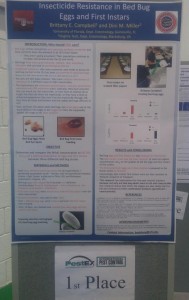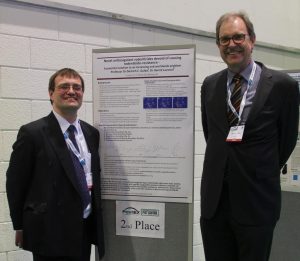IPC – BPCA PestEx 2015 Poster Competition Results
Congratulations to Britanny Campbell in winning the IPC-BPCA PestEx 2015 poster competition.
Abstract of the winning entry.
Insecticide Resistance in Bed Bug, Cimex lectularius, Eggs and First Instars
Brittany E. Campbell1and Dini M. Miller2
1University of Florida, Department of Entomology, Gainesville, FL, US
2Virginia Tech, Department of Entomology, Blacksburg, VA, US
Bed bugs continue to proliferate across the United States and the world. While travel helps them spread across the world, their persistence is contributed widely to their ability to combat the insectic ides we use to try to kill them. Pyrethroid resistance has been well documented in adult bed bugs, but thus far other bed bug life stages have been neglected in resistance studies. While all bed bug life stages are difficult to control, the egg stage is particularly difficult to kill with many of the registered products available for bed bugs. Alternatively, many pest control operators in the United States will do follow-up treatments with liquid insecticides two weeks after an initial treatment to kill first instars that hatch out of the eggs (and any other bed bugs that were missed in the first treatment). The goal of this study was to determine insecticide resistance in eggs and first instars of the common bed bug, Cimex lectularius, and try to distinguish why the egg stage is particularly hard to kill and whether first instars are really that vulnerable to insecticides.
ides we use to try to kill them. Pyrethroid resistance has been well documented in adult bed bugs, but thus far other bed bug life stages have been neglected in resistance studies. While all bed bug life stages are difficult to control, the egg stage is particularly difficult to kill with many of the registered products available for bed bugs. Alternatively, many pest control operators in the United States will do follow-up treatments with liquid insecticides two weeks after an initial treatment to kill first instars that hatch out of the eggs (and any other bed bugs that were missed in the first treatment). The goal of this study was to determine insecticide resistance in eggs and first instars of the common bed bug, Cimex lectularius, and try to distinguish why the egg stage is particularly hard to kill and whether first instars are really that vulnerable to insecticides.
Three strains of bed bugs were used for this study, one pyrethroid-susceptible and two pyrethroid-resistant field collected strains. Mortality was monitored for eggs and first instars treated with two insecticides (Temprid SC and Transport GHP). LC50 (the lethal concentration required to kill 50% of an insect population) values were determined for both life stages. Higher concentrations of insecticides were required for egg and first instar mortality from resistant populations compared to the pyrethroid-susceptible strain. Just like the adults, this research suggests that resistance is present even in the early developmental bed bug stages (eggs and first instars) and could cause pest control operators to have treatment failures.
Download PDF of the winning poster
Also congratulations also to Henrik Luessen for coming in 2nd place.
Abstract of the 2nd place entry.
Novel anticoagulant rodenticides devoid of causing rodenticide-resistance – A potential solution to an increasing and worldwide problem
D.C. Gulba (Essen, Germany) & Henrik Luessen
Background:
Rodent associated annual agricultural loss is estimated to exceed 10% up to 25 % of the annual food production in the world. In addition, these animals serve as carriers of severe human diseases and epidemic plagues of which (Ebola) – an infection causing hemorrhagic fever with a >90% case fatality – has recently received mournful attention. To minimize rodent associated agricultural and human damages pest control has been sought from periodic rodenticide campaigns.
 During the past 5 decades, oral anticoagulants (coumarin- and indandione- derivatives) have been the rodenticide of choice due to their safety and efficacy to eradicate entire rodent colonies. Meanwhile, however, an increasing number of rodent tribes have developed resistance mechanisms rendering the current anticoagulants completely insensitive to such rodenticides. The number of territories with the majority of rodents that are found resistant to the current coumarin- and indandione type rat poisons is expanding fast and even complete resistance has become a fact in some areas. Just recently, within our research a new type of rodenticides have been discovered that are devoid of the limitations of the current anticoagulant type rodenticides.
During the past 5 decades, oral anticoagulants (coumarin- and indandione- derivatives) have been the rodenticide of choice due to their safety and efficacy to eradicate entire rodent colonies. Meanwhile, however, an increasing number of rodent tribes have developed resistance mechanisms rendering the current anticoagulants completely insensitive to such rodenticides. The number of territories with the majority of rodents that are found resistant to the current coumarin- and indandione type rat poisons is expanding fast and even complete resistance has become a fact in some areas. Just recently, within our research a new type of rodenticides have been discovered that are devoid of the limitations of the current anticoagulant type rodenticides.
Problem:
Current coumarin- and indandione- type rodenticides exert delayed toxicity via Vitamin K antagonism. Vitamin K is essential for the synthesis of active coagulation factors II, VII, IX and X. Associated with this synthesis Vitamin K is oxidized to an epoxide and later in the process recycled in a NADPH dependent manner. High doses of coumarin- and indandione- type anticoagulants prevent the vitamin K epoxide from recycling and as a consequence, rodents can no longer synthesize the functionally active coagulation factors II, VII, IX and X, which get them into a fatal hemophilic state. Coumarin- and indandione resistance emerges from genetic selection of such animals that can activate an alternative, disulfide dependent (instead of the NADPH-dependent) reduction pathway.
New rodenticide approach:
We identified five families of novel rodenticides covered by our recently submitted patent [1], which are basically derivatives of:
1. benzimidazolcarbonylpyridylaminopropionate
2. hydroxycarbaminidoylphenylmethylcarbamylaztidinaminoazetate
3. methyloxohydrobenzolisobenzfurancarbamat
4. cyclopropyloxoethylthienopyridinacetat or
5. cyclopropylaminotriazolopyrimidincyclopentan.
Their major advantages are that they
a) are readily orally available
b) do not interfere with the synthesis of coagulation factors
c) inhibit blood coagulation by direct interaction with the coagulation factors
d) act by a mechanism independent from Vitamin K and Vitamin K recycling; and
e) are devoid of any existing or foreseeable mechanism of resistance
Summary and Conclusion:
We describe five families of novel anticoagulant type rodenticides that exert their activity by direct molecular interactions with specific coagulation proteins (factors) and that are completely devoid of any existing and foreseeable resistance -mechanism. These novel anticoagulant-type of rodenticides may create the solution to the increasing worldwide problem of rodenticide resistance.
Literature
[1] Gulba, DC, Patent application DE 10 2014 108 210.9 (2014).
Download PDF of 2nd place poster
Category: Public health











